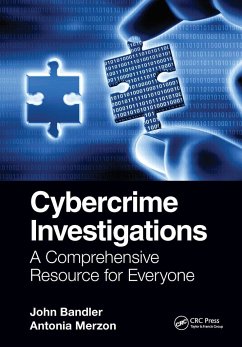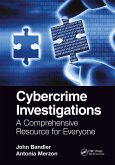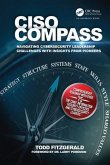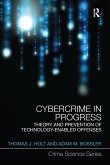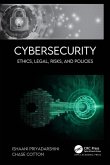- Gebundenes Buch
- Merkliste
- Auf die Merkliste
- Bewerten Bewerten
- Teilen
- Produkt teilen
- Produkterinnerung
- Produkterinnerung
This book is a comprehensive resource for everyone who encounters and investigates cybercrime, no matter their title, including those working on behalf of law enforcement, private organizations, regulatory agencies, or individual victims.
Andere Kunden interessierten sich auch für
![Cybercrime Investigations Cybercrime Investigations]() John BandlerCybercrime Investigations48,99 €
John BandlerCybercrime Investigations48,99 €![CISO COMPASS CISO COMPASS]() Todd FitzgeraldCISO COMPASS127,99 €
Todd FitzgeraldCISO COMPASS127,99 €![Cybercrime in Progress Cybercrime in Progress]() Thomas HoltCybercrime in Progress55,99 €
Thomas HoltCybercrime in Progress55,99 €![Cybersecurity for Decision Makers Cybersecurity for Decision Makers]() Cybersecurity for Decision Makers162,99 €
Cybersecurity for Decision Makers162,99 €![Advanced Criminal Investigations and Intelligence Operations Advanced Criminal Investigations and Intelligence Operations]() Robert J. Girod (Robert J. Girod Consulting, LLC, Fort Wayne, IndiaAdvanced Criminal Investigations and Intelligence Operations54,99 €
Robert J. Girod (Robert J. Girod Consulting, LLC, Fort Wayne, IndiaAdvanced Criminal Investigations and Intelligence Operations54,99 €![Cybersecurity Cybersecurity]() Ishaani PriyadarshiniCybersecurity87,99 €
Ishaani PriyadarshiniCybersecurity87,99 €![What To Do When You Get Hacked What To Do When You Get Hacked]() Shimon BrathwaiteWhat To Do When You Get Hacked82,99 €
Shimon BrathwaiteWhat To Do When You Get Hacked82,99 €-
-
-
This book is a comprehensive resource for everyone who encounters and investigates cybercrime, no matter their title, including those working on behalf of law enforcement, private organizations, regulatory agencies, or individual victims.
Hinweis: Dieser Artikel kann nur an eine deutsche Lieferadresse ausgeliefert werden.
Hinweis: Dieser Artikel kann nur an eine deutsche Lieferadresse ausgeliefert werden.
Produktdetails
- Produktdetails
- Verlag: Taylor & Francis Ltd
- Seitenzahl: 360
- Erscheinungstermin: 3. Juli 2020
- Englisch
- Abmessung: 257mm x 183mm x 25mm
- Gewicht: 848g
- ISBN-13: 9780367196233
- ISBN-10: 0367196239
- Artikelnr.: 68430325
- Herstellerkennzeichnung
- Libri GmbH
- Europaallee 1
- 36244 Bad Hersfeld
- gpsr@libri.de
- Verlag: Taylor & Francis Ltd
- Seitenzahl: 360
- Erscheinungstermin: 3. Juli 2020
- Englisch
- Abmessung: 257mm x 183mm x 25mm
- Gewicht: 848g
- ISBN-13: 9780367196233
- ISBN-10: 0367196239
- Artikelnr.: 68430325
- Herstellerkennzeichnung
- Libri GmbH
- Europaallee 1
- 36244 Bad Hersfeld
- gpsr@libri.de
John Bandler and Antonia Merzon served together as Assistant District Attorneys at the New York County District Attorney's Office (DANY), hired by the legendary Robert Morgenthau. They investigated and prosecuted a wide variety of criminal offenses, ranging from those that garnered headlines to the many that received little attention but were equally essential for the administration of justice and protection of the public. Antonia founded and led the Identity Theft Unit (since renamed the Cybercrime and Identity Theft Bureau), recruiting John as an early member. The unit's work quickly revealed the close connection between identify theft and cybercrime, and brought amazing cases, including the Western Express case, which you will read about. John Bandler runs a law firm and a consulting practice that helps organizations and individuals with cybersecurity, cybercrime investigations, and anti-money laundering efforts among other areas. Before becoming a prosecutor, he served as a State Trooper in the New York State Police for eight years, assigned to one of the state's busiest stations that provided full police services to the local community. While serving in the State Police he attended law school at night at Pace University School of Law, and upon graduating he went to work for Mr. Morgenthau. Since leaving government service he has represented a range of clients, from individuals to banks, on many issues ranging from cybersecurity, privacy, anti-fraud, and threats. John is admitted to the bars of New York, Connecticut, and Washington D.C., holds a number of certifications, and writes, lectures, and teaches on law, cybersecurity, cybercrime, and more. Antonia Merzon provides legal and consulting expertise related to security, investigations and law enforcement, especially as they intersect with the worlds of law, technology, privacy, and fraud. She graduated from Fordham University School of Law and then was hired by Mr. Morgenthau. During her time at DANY, she built the new Identity Theft Unit that investigated and prosecuted cybercrime and virtual currency money laundering - before these areas were in the public awareness - and developed the unit's digital forensic and investigative capacity. Cybercrime and traditional investigations are among her specialties, including developing best practices. She also is an expert on a diverse array of investigation and litigation best practices for law enforcement, including the use of body-worn cameras, eyewitness identification, and the electronic recording of custodial interrogations.
Part 1: Cyber Law.
1. Introduction.
2. Cybercrimes and Criminal Statutes.
3. Laws Pertaining to the Criminal Investigative Process.
4. Nation State and Terrorist Nexus.
5. Civil and Regulatory Issues Relating to Cybercrime. Part 2: The Criminal
Investigation.
6. The Crime (Act).
7. Gathering Leads and Potential Evidence.
8. Following the Money.
9. Gathering Records and Evidence with an Eye towards Potential Trial.
10. Identification and Attribution of the Suspect.
11. Getting Technical.
12. Apprehending the Suspect and Follow on Actions.
13. The Criminal Investigation and Case Continues after Arrest. Part 3: The
Civil Investigation.
14. Comparing the Civil Investigation to the Criminal Investigation.
15. Civil Legal Process Available.
16. E-Discovery.
17. Sharing with Law Enforcement. Part 4: Appendix.
18. Statutes.
19. Criminal Cases.
20. Civil Cases.
21. Cybercrime Investigation Organizations.
22. Cybersecurity Organizations.
1. Introduction.
2. Cybercrimes and Criminal Statutes.
3. Laws Pertaining to the Criminal Investigative Process.
4. Nation State and Terrorist Nexus.
5. Civil and Regulatory Issues Relating to Cybercrime. Part 2: The Criminal
Investigation.
6. The Crime (Act).
7. Gathering Leads and Potential Evidence.
8. Following the Money.
9. Gathering Records and Evidence with an Eye towards Potential Trial.
10. Identification and Attribution of the Suspect.
11. Getting Technical.
12. Apprehending the Suspect and Follow on Actions.
13. The Criminal Investigation and Case Continues after Arrest. Part 3: The
Civil Investigation.
14. Comparing the Civil Investigation to the Criminal Investigation.
15. Civil Legal Process Available.
16. E-Discovery.
17. Sharing with Law Enforcement. Part 4: Appendix.
18. Statutes.
19. Criminal Cases.
20. Civil Cases.
21. Cybercrime Investigation Organizations.
22. Cybersecurity Organizations.
Part 1: Cyber Law.
1. Introduction.
2. Cybercrimes and Criminal Statutes.
3. Laws Pertaining to the Criminal Investigative Process.
4. Nation State and Terrorist Nexus.
5. Civil and Regulatory Issues Relating to Cybercrime. Part 2: The Criminal Investigation.
6. The Crime (Act).
7. Gathering Leads and Potential Evidence.
8. Following the Money.
9. Gathering Records and Evidence with an Eye towards Potential Trial.
10. Identification and Attribution of the Suspect.
11. Getting Technical.
12. Apprehending the Suspect and Follow on Actions.
13. The Criminal Investigation and Case Continues after Arrest. Part 3: The Civil Investigation.
14. Comparing the Civil Investigation to the Criminal Investigation.
15. Civil Legal Process Available.
16. E-Discovery.
17. Sharing with Law Enforcement. Part 4: Appendix.
18. Statutes.
19. Criminal Cases.
20. Civil Cases.
21. Cybercrime Investigation Organizations.
22. Cybersecurity Organizations.
1. Introduction.
2. Cybercrimes and Criminal Statutes.
3. Laws Pertaining to the Criminal Investigative Process.
4. Nation State and Terrorist Nexus.
5. Civil and Regulatory Issues Relating to Cybercrime. Part 2: The Criminal Investigation.
6. The Crime (Act).
7. Gathering Leads and Potential Evidence.
8. Following the Money.
9. Gathering Records and Evidence with an Eye towards Potential Trial.
10. Identification and Attribution of the Suspect.
11. Getting Technical.
12. Apprehending the Suspect and Follow on Actions.
13. The Criminal Investigation and Case Continues after Arrest. Part 3: The Civil Investigation.
14. Comparing the Civil Investigation to the Criminal Investigation.
15. Civil Legal Process Available.
16. E-Discovery.
17. Sharing with Law Enforcement. Part 4: Appendix.
18. Statutes.
19. Criminal Cases.
20. Civil Cases.
21. Cybercrime Investigation Organizations.
22. Cybersecurity Organizations.
Part 1: Cyber Law.
1. Introduction.
2. Cybercrimes and Criminal Statutes.
3. Laws Pertaining to the Criminal Investigative Process.
4. Nation State and Terrorist Nexus.
5. Civil and Regulatory Issues Relating to Cybercrime. Part 2: The Criminal
Investigation.
6. The Crime (Act).
7. Gathering Leads and Potential Evidence.
8. Following the Money.
9. Gathering Records and Evidence with an Eye towards Potential Trial.
10. Identification and Attribution of the Suspect.
11. Getting Technical.
12. Apprehending the Suspect and Follow on Actions.
13. The Criminal Investigation and Case Continues after Arrest. Part 3: The
Civil Investigation.
14. Comparing the Civil Investigation to the Criminal Investigation.
15. Civil Legal Process Available.
16. E-Discovery.
17. Sharing with Law Enforcement. Part 4: Appendix.
18. Statutes.
19. Criminal Cases.
20. Civil Cases.
21. Cybercrime Investigation Organizations.
22. Cybersecurity Organizations.
1. Introduction.
2. Cybercrimes and Criminal Statutes.
3. Laws Pertaining to the Criminal Investigative Process.
4. Nation State and Terrorist Nexus.
5. Civil and Regulatory Issues Relating to Cybercrime. Part 2: The Criminal
Investigation.
6. The Crime (Act).
7. Gathering Leads and Potential Evidence.
8. Following the Money.
9. Gathering Records and Evidence with an Eye towards Potential Trial.
10. Identification and Attribution of the Suspect.
11. Getting Technical.
12. Apprehending the Suspect and Follow on Actions.
13. The Criminal Investigation and Case Continues after Arrest. Part 3: The
Civil Investigation.
14. Comparing the Civil Investigation to the Criminal Investigation.
15. Civil Legal Process Available.
16. E-Discovery.
17. Sharing with Law Enforcement. Part 4: Appendix.
18. Statutes.
19. Criminal Cases.
20. Civil Cases.
21. Cybercrime Investigation Organizations.
22. Cybersecurity Organizations.
Part 1: Cyber Law.
1. Introduction.
2. Cybercrimes and Criminal Statutes.
3. Laws Pertaining to the Criminal Investigative Process.
4. Nation State and Terrorist Nexus.
5. Civil and Regulatory Issues Relating to Cybercrime. Part 2: The Criminal Investigation.
6. The Crime (Act).
7. Gathering Leads and Potential Evidence.
8. Following the Money.
9. Gathering Records and Evidence with an Eye towards Potential Trial.
10. Identification and Attribution of the Suspect.
11. Getting Technical.
12. Apprehending the Suspect and Follow on Actions.
13. The Criminal Investigation and Case Continues after Arrest. Part 3: The Civil Investigation.
14. Comparing the Civil Investigation to the Criminal Investigation.
15. Civil Legal Process Available.
16. E-Discovery.
17. Sharing with Law Enforcement. Part 4: Appendix.
18. Statutes.
19. Criminal Cases.
20. Civil Cases.
21. Cybercrime Investigation Organizations.
22. Cybersecurity Organizations.
1. Introduction.
2. Cybercrimes and Criminal Statutes.
3. Laws Pertaining to the Criminal Investigative Process.
4. Nation State and Terrorist Nexus.
5. Civil and Regulatory Issues Relating to Cybercrime. Part 2: The Criminal Investigation.
6. The Crime (Act).
7. Gathering Leads and Potential Evidence.
8. Following the Money.
9. Gathering Records and Evidence with an Eye towards Potential Trial.
10. Identification and Attribution of the Suspect.
11. Getting Technical.
12. Apprehending the Suspect and Follow on Actions.
13. The Criminal Investigation and Case Continues after Arrest. Part 3: The Civil Investigation.
14. Comparing the Civil Investigation to the Criminal Investigation.
15. Civil Legal Process Available.
16. E-Discovery.
17. Sharing with Law Enforcement. Part 4: Appendix.
18. Statutes.
19. Criminal Cases.
20. Civil Cases.
21. Cybercrime Investigation Organizations.
22. Cybersecurity Organizations.

